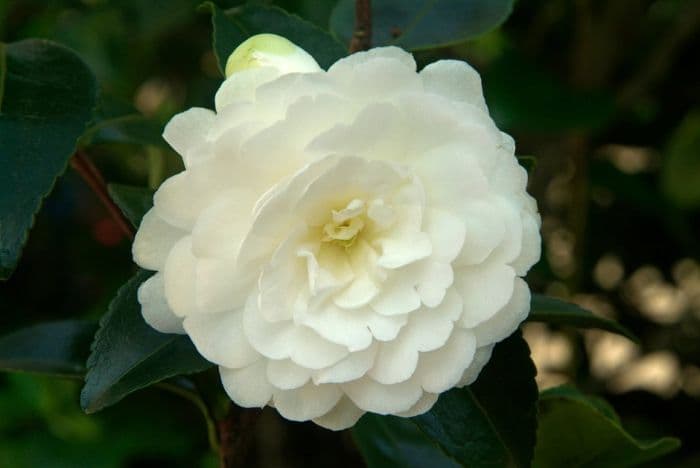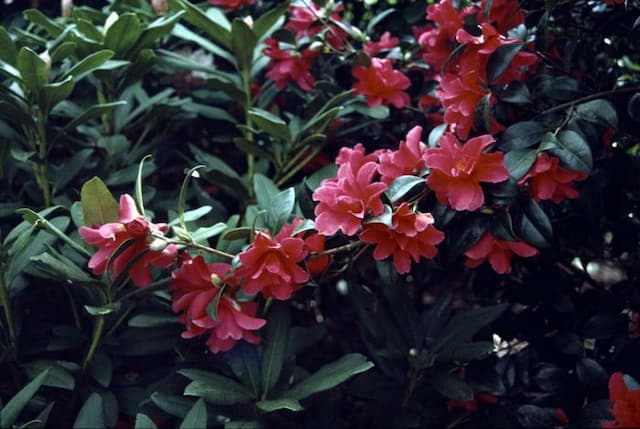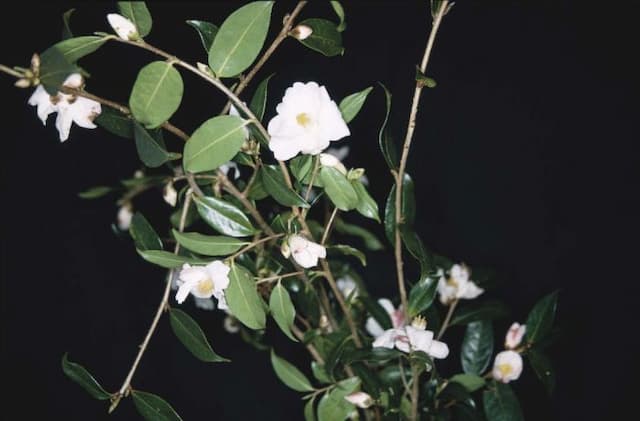Sasanqua camellia Camellia sasanqua 'Fuji-no-mine'

ABOUT
The Camellia sasanqua 'Fuji-no-mine', commonly referred to simply as sasanqua camellia, is an ornamental shrub recognized for its charming and graceful flowers. The plant boasts semi-double blooms that exude a delicate appeal, featuring petals that are gently layered upon each other in a symmetrical fashion. These blossoms are predominantly white, a color that stands out against the plant's lush green foliage. The leaves exhibit a glossy texture, contributing to the plant's overall lustrous appearance. The foliage presents a leathery feel with a smooth margin, forming a dense and verdant backdrop for the flowers. The sasanqua camellia's blossoms are distinguished by their lovely shape and the slight ruffle along the edges of the petals which adds texture and depth to the flower's appearance. Each flower comprises a conspicuous central cluster of prominent yellow stamens, creating a striking contrast that enhances the visual impact of the white petals. This juxtaposition of the vivid yellow against the pure white makes the flowers particularly eye-catching. The growth habit of the sasanqua camellia is elegant and graceful, contributing to its popularity as a garden plant. It often displays a natural form that makes it a versatile addition to landscapes, capable of complementing various garden themes and styles. Its attractive appearance makes it a favorite among gardeners seeking to add a touch of refinement to their outdoor spaces. The sasanqua camellia blooms during the cooler months of the year, providing a burst of beauty in the garden when many other plants have ceased their show.
About this plant
 Names
NamesFamily
Theaceae
Synonyms
Sasanqua Camellia, Yuletide Camellia, Christmas Camellia
Common names
Camellia sasanqua 'Fuji-no-mine'.
 Toxicity
ToxicityTo humans
The sasanqua camellia is not known to be toxic to humans. There are no commonly reported symptoms of poisoning from ingesting parts of this plant, as it is generally considered non-toxic.
To pets
The sasanqua camellia is also not known to be toxic to pets. Ingesting parts of this plant typically does not lead to poisoning, and there are no widely recognized health consequences for pets that consume this plant. It is considered generally safe around animals.
 Characteristics
CharacteristicsLife cycle
Perennials
Foliage type
Evergreen
Color of leaves
Green
Flower color
White
Height
4-5 feet (1.2-1.5 meters)
Spread
5-6 feet (1.5-1.8 meters)
Plant type
Shrub
Hardiness zones
7
Native area
Japan
Benefits
 General Benefits
General Benefits- Ornamental Beauty: Camellia sasanqua 'Fuji-no-mine', commonly known as Sasanqua camellia, adds aesthetic value to gardens with its elegant, white, frilly flowers during fall and winter months.
- Long Blooming Season: Its blooming season is longer compared to many other camellias, providing color and beauty when most other plants are dormant.
- Drought Tolerance: Once established, it has good drought tolerance, making it suitable for gardens in drier climates.
- Cold Resistance: It is relatively cold-hardy compared to other camellias, enduring cooler temperatures without significant damage.
- Low Maintenance: Sasanqua camellia requires minimal pruning and care, making it an easy choice for both novice and experienced gardeners.
- Versatility in Landscaping: It can be used as a hedge, screen, espalier, container plant, or as a spectacular specimen, offering flexibility in garden design.
- Attracts Pollinators: The flowers attract pollinators such as bees and butterflies, supporting local ecosystems.
- Shade Tolerance: It tolerates partial shade, allowing it to be planted in various light conditions within a garden setting.
- Deer Resistance: Sasanqua camellia is generally resistant to deer, which makes it a suitable plant for gardens in areas with high deer populations.
- Evergreen Foliage: Its evergreen leaves provide year-round interest and foliage, even when not in bloom.
 Medical Properties
Medical PropertiesThis plant is not used for medical purposes.
 Air-purifying Qualities
Air-purifying QualitiesThis plant is not specifically known for air purifying qualities.
 Other Uses
Other Uses- Edible decoration: The petals of Camellia sasanqua, also known as sasanqua camellia, can be used to decorate salads or desserts for an elegant touch.
- Dye production: The flowers can be used to make natural dyes for fabrics, yielding delicate hues.
- Crafts: Dried flowers and leaves can be incorporated into potpourri, wreaths, or other dried floral arrangements.
- Insect repellent: Some parts of the plant are believed to contain compounds that can repel certain insects when used in gardens.
- Candle making: Dried petals can be embedded in wax to create decorative and potentially fragrant candles.
- Art supplies: The seeds can be pressed for oil that is sometimes used as a binder in artist-grade paints.
- Photography: Sasanqua camellia blooms are popular subjects in botanical and garden photography thanks to their aesthetic appeal.
- Traditional crafts: In Japan, the leaves are used in the art of Tsubaki-bana, where they are folded into shapes and floated on water.
- Hair adornment: In some cultures, the blossoms are worn in the hair during traditional ceremonies or festivals as natural accessories.
- Scented sachets: Dried blooms and leaves can be used to make scented sachets for drawers and closets.
Interesting Facts
 Feng Shui
Feng ShuiSasanqua Camellia is not used in Feng Shui practice.
 Zodiac Sign Compitability
Zodiac Sign CompitabilitySasanqua Camellia is not used in astrology practice.
 Plant Symbolism
Plant Symbolism- Longevity - Camellias have a long blooming season and the plants themselves can live for many years, often representing enduring or long life.
- Love - In many cultures, camellias are associated with love and affection. The enduring nature of the flower symbolizes deep, lasting romantic love.
- Admiration - The beauty of the camellia bloom is often seen as a symbol of admiration. When given as a gift, it can convey the giver's admiration for the receiver.
- Perfection - The camellia's symmetrical form and perfection of petals represent the ideal or perfection in beauty or accomplishment.
- Devotion - Similar to love, the camellia can symbolize devotion or deep commitment to someone, expressing the strong ties and loyalty in a relationship.
 Water
WaterSasanqua camellias require consistent moisture, so they should be watered deeply and thoroughly to encourage deep root development. During the growing season, water them at least once a week with about 1-1.5 gallons per square foot of soil area. In hot and dry weather, increase the frequency to twice a week. Make sure the soil is well-draining to avoid waterlogging. In the winter, reduce watering to when the soil feels dry to the touch.
 Light
LightSasanqua camellias thrive in partial shade, ideally receiving morning sun and afternoon shade. Avoid direct, hot afternoon sun, which can scorch the leaves. A spot with filtered light or dappled sunlight throughout the day is also suitable for maintaining healthy foliage and vibrant blooms.
 Temperature
TemperatureSasanqua camellias are hardy in USDA zones 7-9 and prefer a temperature range of 60-70 degrees Fahrenheit during the day and slightly cooler at night. They can withstand minimum temperatures down to 10 degrees Fahrenheit but require protection from cold winter winds. The ideal temperature conditions should be maintained to ensure vigorous growth and successful flowering.
 Pruning
PruningPrune sasanquas to maintain shape, remove dead or weak wood, and promote airflow within the canopy. The best time to prune is just after flowering has finished, usually in late winter or early spring. Minimal pruning is often enough, with more extensive pruning done every few years. Pruning too late in the season can remove potential flower buds for the following year.
 Cleaning
CleaningAs needed
 Soil
SoilSasanqua camellias thrive in acidic, well-draining soil with a pH between 5.5-6.5. A mix of 1/3 pine bark, 1/3 peat moss, and 1/3 perlite or sand is ideal.
 Repotting
RepottingSasanqua camellias should be repotted every 2-4 years in the spring, just before the growing season begins.
 Humidity & Misting
Humidity & MistingSasanqua camellias prefer moderate to high humidity levels, ideally between 50-60%, to thrive.
 Suitable locations
Suitable locationsIndoor
Place sasanquas near a bright window and maintain humidity for indoor growing.
Outdoor
Plant sasanquas in partial shade with shelter from hot afternoon sun.
Hardiness zone
7-9 USDA.
 Life cycle
Life cycleThe sasanqua camellia 'Fuji-no-mine' begins its life cycle as a seed, which when planted in well-draining, acidic soil and with the right conditions, will germinate and sprout. The seedling gradually develops into a young plant with glossy, evergreen leaves, and over several years, it matures into a bushy shrub. Once the plant reaches maturity, typically after 2-5 years, it begins to produce buds that will bloom into white, fragrant flowers in the fall and winter months. After pollination, which can occur via insects such as bees, the flowers produce dry capsules containing seeds that can be dispersed to begin a new generation. The mature sasanqua camellia 'Fuji-no-mine' continues to grow and produce flowers annually. This plant can live for many years, often several decades, with proper care and favorable conditions.
 Propogation
PropogationPropogation time
Late Winter to Early Spring
Propogation: Camellia sasanqua 'Fuji-no-mine', commonly known as Sasanqua Camellia, is often propagated using semi-hardwood cuttings. This method typically takes place in late summer. You would begin by selecting a healthy, disease-free branch that has matured but is not overly woody. A cutting of 4 to 6 inches (approximately 10 to 15 centimeters) should be taken, just below a leaf node. The lower leaves are removed, and the cut end is often dipped in rooting hormone to encourage root development. This cutting is then placed in a well-draining rooting medium, such as a mixture of peat and perlite, and kept at a consistent moisture level. A propagation environment with high humidity and temperatures around 70 to 75 degrees Fahrenheit (21 to 24 degrees Celsius) will favor root development.









